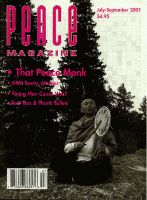
Peace Magazine Jul-Sep 2001, page 13. Some rights reserved.
Search for other articles by Ken Simons here
Three hundred and seventy plastic bullets were fired by police during the Summit of the Americas in Québec, causing at least one serious injury and many minor injuries. Some warnings from Northern Ireland on baton rounds and crowd control
The plastic bullet is a weapon designed to inflict non-lethal injury on participants in a riot or other civil disturbance. It was the fourth of five levels of response for police at the Summit of the Americas in Québec City - just below live ammunition - but was resorted to frequently and with little provocation. The repeated use of plastic bullets against unarmed civilians suggested that the Royal Canadian Mounted Police and the Sureté du Québec learned nothing from the experiences of the British security forces in Northern Ireland.
The inspiration for the modern plastic bullet was the police truncheon, which would cause pain and temporary disability but rarely permanent injury or death. In the mid-1960s, police in the British colony of Hong Kong used 2.5cm long teak bullets, fired from conventional large-bore weapons, to control trade union and anti-colonial protesters. The bullets appeared to be as effective as a hand-held truncheon without presenting any risk to the officers who used it; but the damage caused by the new "non-lethal" ammunition was unpredictable and in some cases lethal. The teak bullets splintered; they hit the body harder than a nightstick; and they went off-target.
In the 1960s, Britain's state-owned Royal Ordnance Company developed a large-bore, low-velocity weapon for firing rubber baton rounds. The Anti-Riot Weapon Enfield, or Arwen-37, is still used today with a wide range of ammunition; in Québec City, Canadian-made Arwen-37s launched both rubber bullets and CS gas.
Rubber bullet launchers were first used in Northern Ireland in 1970, under rules stipulating that they were to be fired at the ground in front of a crowd, causing the bullets to ricochet and strike people in the lower body with minimal harm. They were not to be fired directly into a crowd or at a range of less than 20 metres. These regulations were soon flouted, as the army used 55,000 of the 15 centimetre-long rubber bullets during 1970-74, often at close range and where there was no threat to the police. The first fatality was an 11-year-old boy, shot from 5-6 metres. A witness said a battery had been inserted into the bullet to increase its weight and impact.
In another case, a 51-year-old woman was shot through her own kitchen window and permanently blinded. She had been playing an Irish rebel song on her record player. She later made a successful case for compensation; the threat of civil lawsuits for unlawful injury was a major factor in the army's 1975 decision to stop using rubber baton rounds.
But polyvinyl chloride plastic bullets, introduced in 1973, were considered safe enough to continue in use in the north of Ireland. Regulations for the firing of plastic bullets specified that they were to be aimed directly at the lower body, not at the ground. The operational range was 20 to 70 metres.
From 1975 to 1986, 14 people died in Northern Ireland after being hit by plastic bullets. All but one were Catholic; seven were children. Injuries were widespread; while blindings were less common than with the earlier rubber bullets, other blunt-force traumas occurred.
In 1982, the European Parliament banned the use of plastic bullets by national security forces, a ban ignored by the British army and the Royal Ulster Constabulary. The last death by plastic bullet occured in 1987; but serious injuries were reported until the late 1990s.
A modified baton round and gun were introduced in Northern Ireland in 1994 and has been used intermittently since then, with only 112 rounds discharged in 1999 and 26 in 2000. The Independent Commission on Policing for Northern Ireland, under former Hong Kong governor Chris Patten, stopped short of calling for a complete ban on the weapons, but recommended that their use be greatly curtailed and alternative forms of crowd control researched. The commission recommended that police should be trained to think of the weapon as they would think of a firearm, "that is, as a weapon which is potentially lethal."
Ken Simons is a former editor of Peace News (London) and a Peace Magazine associate editor.

Peace Magazine Jul-Sep 2001, page 13. Some rights reserved.
Search for other articles by Ken Simons here